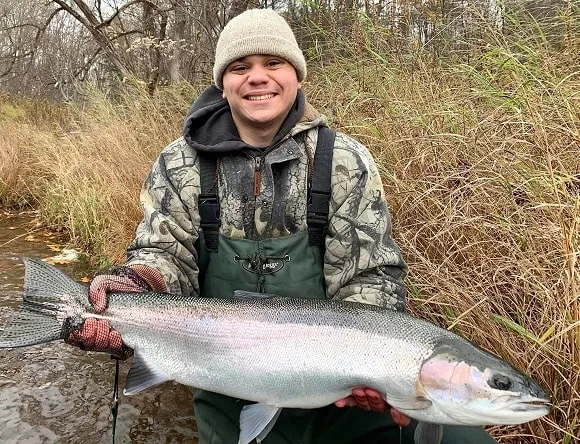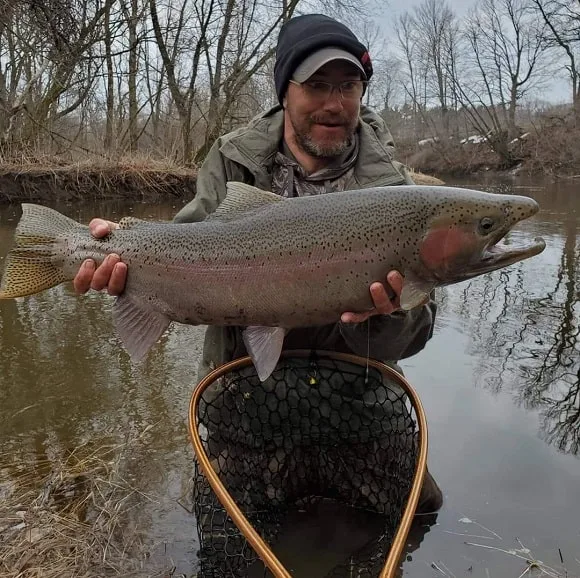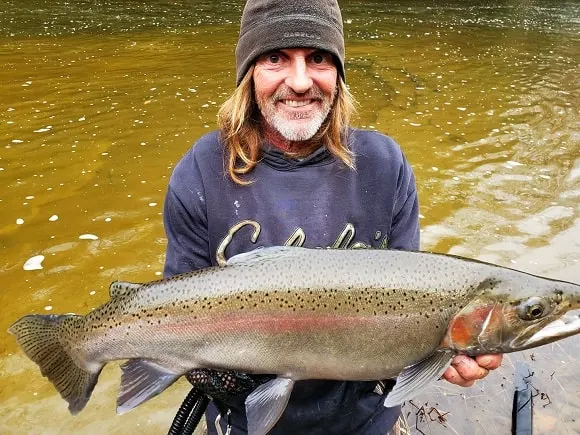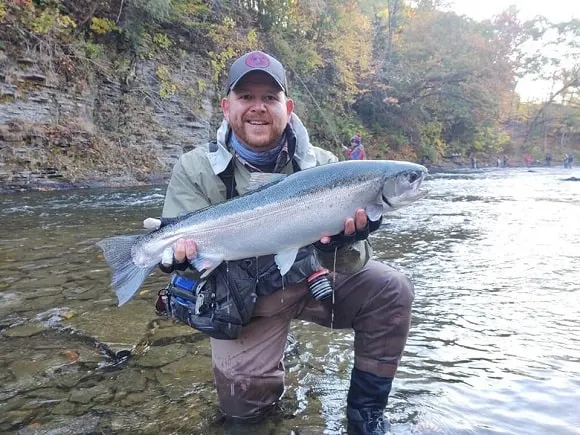Steelhead are one of America’s most popular game fish. They taste delicious, can grow to very respectable sizes, and are fierce fighters on the rod.
Many anglers target them during the spawning season when thousands and thousands of them migrate upstream to reach their spawning grounds. But when exactly do steelhead spawn?
Most steelhead in the US spawn sometime between January and April in water temperatures of about 40 to 50ºF. They prefer shallow water of 1 to 4 feet and most commonly build their nests on gravel or cobble beds.
If you want to learn everything there is to know about the steelhead spawn and if and where you can catch them during the spawning season, all you have to do is keep reading!
What Time of Year Do Steelhead Spawn?
Even for trout and salmon standards, steelhead (Oncorhynchus mykiss) have an exceptionally long spawning season that generally stretches from January to April.
Occasional early spawnings can happen in December, and sometimes, the steelhead spawn can occur as late as May.
In other words, that’s almost half a year during which this trout type could spawn.
Furthermore, steelhead populations usually spawn in several smaller and bigger runs and enter their spawning rivers and creeks at different times of the year.
Some river systems have summer runs that see fish in the river as early as June or July.
These summer steelies (also called Skamania) will spend the fall and early winter in the river and spawn sometime between January and March.
On the contrary, winter-run steelhead may enter their natal rivers, streams, and creeks as late as January, February, or March and then spawn sometime in April or even May.
The fact of the matter is that there is no exact time of the spawn!
Some stocks can spend many weeks or even months in a river before they start spawning.
Others may start spawning shortly after they’ve entered the river.
That’s why you can catch steelhead during so many months of the year in many waters!
At What Water Temperature Do Steelhead Spawn?

The ideal water temperature for the steelhead spawn is 40 to 50ºF. That’s when the fish will be active enough to get through the act of spawning, and the eggs have the highest chance of survival.
They can spawn in temperatures as low as 37 to 38 degrees Fahrenheit, but if possible, they will wait until the water has warmed up a few degrees more.
Meanwhile, steelhead spawning has been observed at up to 58ºF.
However, since there will be much less dissolved oxygen in water temperatures between 50 and 60 degrees Fahrenheit, egg mortality is likely much higher than in lower temperatures of about 40 to 45ºF.
Where Do Steelhead Spawn?
As mentioned above, all steelhead spawn in freshwater rivers and creeks. Whether they are found in the ocean or the Great Lakes, when it’s time to get spawning, they all end up in moving water!
Of course, many paths lead to the spawn, which is why there are so many steelhead fishing opportunities in America.
This ranges from huge river systems that empty into the ocean to the tiniest creeks and streams.
Steelhead (and often other trout and salmon species) will find their way to their spawning grounds, no matter how shallow the water or how many obstacles there may be!
Most fish will choose the tops of riffles to build their nests in.
These provide plenty of oxygenated water for the eggs, and the often connected deeper and calmer pools offer the perfect resting place for newly arrived steelhead or pre-spawn fish that need to charge their energy reserves for the coming spawn.
So, if you’re searching for pre-spawn steelies (as these fish will actually bite), try to find those deeper pools!
What Depth Do Steelhead Spawn at?

Steelhead prefer fast-flowing and shallow river sections for spawning and typically spawn in water depths of 1 to 4 feet.
Generally speaking, the shallow the water, the better suited it is for the steelhead, and in many smaller rivers and creeks, they will spawn in depths of less than a foot.
Such shallow water has several advantages for the spawn:
- Shallow water means a fast and strong current, which provides the eggs with plenty of oxygen.
- Lots of current and movement also means a lower water temperature, which is essential for the steelhead eggs’ survival.
- Bigger predatory fish species will have a much harder time accessing the eggs in so little water. (Salmon and brown trout, among others, love to feast on steelhead eggs)
What Type of Bottom Do Steelhead Need for Spawning?
The bottom types steelhead prefer and need for spawning include gravel and small cobble.
They avoid river beds consisting of silt, sand, or clay.
Gravel and cobble beds are a logical choice, as they keep the eggs on the bottom and prevent them from getting washed away by the strong current.
At the same time, the eggs won’t sink into the bottom, a risk always present on silt, sand, or clay beds.
Can You Catch Steelhead During the Spawn?

While getting actively spawning steelhead to take your bait is pretty much impossible, targeting pre or post-spawn fish can be very productive.
Thanks to the prolonged time the fish spend in the rivers, there are pre or post-spawners around at any given time, giving you, the angler, a very large window of opportunity.
Again, try to find those deeper holes and pools close to the spawning grounds to catch those pre-spawners!
Dropbacks, or post-spawners, on the other hand, can pretty much be found anywhere in the river system.
You can expect plenty of action on good days when the bite is on!
Then, there will also be days when catching them will be virtually impossible. That’s (steelhead) fishing in a nutshell!
How Many Eggs Do Steelhead Lay?
Steelhead eggs are relatively large, resulting in a lower overall number of eggs per female fish. On average, females deposit between 500 and 1,500 eggs.
However, larger specimens can produce between 3,000 and 5,000 eggs.
DID YOU KNOW: In the world of trout and salmon, only the Pacific king or chinook salmon lays larger eggs than steelhead do.
Do Steelhead Die After Spawning?

Unlike salmon, steelhead don’t necessarily have to die after spawning.
Some do die, primarily due to the extreme exhaustion suffered during the journey toward their spawning grounds.
However, most will survive the ordeal, head back to the ocean or the Great Lakes, and then return one or two years later to spawn again.
Those steelhead are commonly referred to as repeat spawners.
The percentage of repeat spawners can vary from river to river and depends on many factors, including:
- population size
- population genetics
- distance from the ocean to the spawning grounds
- predation
- dissolved oxygen levels
- water velocity
- number of obstacles along the migration path
- fishing pressure
Generally speaking, the more favorable all these conditions are, the more fish are likely to survive the spawn and return to saltwater.
RELATED ARTICLE: What Are the Best Weather Conditions for Steelhead Fishing?
Do Steelhead Spawn More Than Once a Year?
So steelhead can spawn more than once during their lifetime, but can they spawn more than once a year?
The answer to this question is no! Steelhead can and will only spawn once every year.
Although it’s easy to assume that steelies would spawn several times a year, given that they spend so much time in their spawning streams.
With so many runs taking place, plenty of fish surely join the fun more than once, right?
Wrong! You see, making the trip upstream and then spawning is extraordinarily challenging and fatiguing for the fish.
Fish that have already completed the act of spawning must preserve their remaining energy for their long and arduous way back to saltwater or the Great Lakes.
It would be impossible for them to spawn a second time during the same season.
Related Articles
- What Is the Biggest Steelhead Ever Caught?
- What Time of Year Do Lake Trout Spawn?
- Can You Catch Rainbow Trout During the Spawn?
Featured image courtesy of Chris Barnhart

